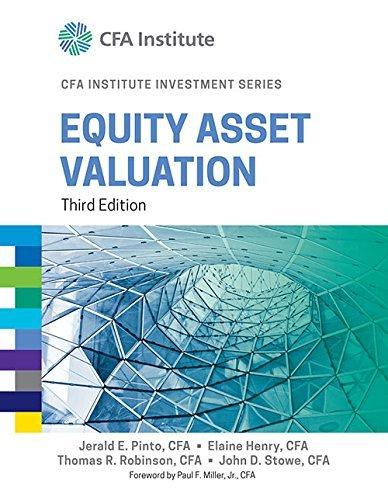According to Statement 5, analysts are expected to use valuation concepts and models to: A. value private
Question:
According to Statement 5, analysts are expected to use valuation concepts and models to:
A. value private businesses.
B. render fairness opinions.
C. extract market expectations.
Guardian Capital is a rapidly growing US investment firm. The Guardian Capital research team is responsible for identifying undervalued and overvalued publicly traded equities that have a market capitalization greater than $500 million.
Due to the rapid growth of assets under management, Guardian Capital recently hired a new analyst, Jack Richardson, to support the research process. At the new analyst orientation meeting, the director of research made the following statements about equity valuation at Guardian:
Statement 1 “Analysts at Guardian Capital seek to identify mispricing, relying on price eventually converging to intrinsic value. However, convergence of the market price to an analyst’s estimate of intrinsic value may not happen within the portfolio manager’s investment time horizon. So, besides evidence of mispricing, analysts should look for the presence of a particular market or corporate event,—that is, a catalyst—that will cause the marketplace to re-evaluate the subject firm’s prospects.”
Statement 2 “An active investment manager attempts to capture positive alpha. But mispricing of assets is not directly observable. It is therefore important that you understand the possible sources of perceived mispricing.”
Statement 3 “For its distressed securities fund, Guardian Capital screens its investable universe of securities for companies in financial distress.”
Statement 4 “For its core equity fund, Guardian Capital selects financially sound companies that are expected to generate significant positive free cash flow from core business operations within a multiyear forecast horizon.”
Statement 5 “Guardian Capital’s research process requires analysts to evaluate the reasonableness of the expectations implied by the market price by comparing the market’s implied expectations to his or her own expectations.”
After the orientation meeting, the director of research asks Richardson to evaluate three companies that are retailers of men’s clothing: Diamond Co., Renaissance Clothing, and Deluxe Men’s Wear.
Richardson starts his analysis by evaluating the characteristics of the men’s retail clothing industry. He finds few barriers to new retail entrants, high intra-industry rivalry among retailers, low product substitution costs for customers, and a large number of wholesale clothing suppliers.
While conducting his analysis, Richardson discovers that Renaissance Clothing included three non-recurring items in their most recent earnings release: a positive litigation settlement, a one-time tax credit, and the gain on the sale of a non-operating asset.
To estimate each firm’s intrinsic value, Richardson applies appropriate discount rates to each firm’s estimated free cash flows over a ten-year time horizon and to the estimated value of the firm at the end of the ten-year horizon.
Michelle Lee, a junior technology analyst at Guardian, asks the director of research for advice as to which valuation model to use for VEGA, a fast growing semiconductor company that is rapidly gaining market share.
The director of research states that “the valuation model selected must be consistent with the characteristics of the company being valued.”
Lee tells the director of research that VEGA is not expected to be profitable for several more years. According to management guidance, when the company turns profitable, it will invest in new product development; as a result, it does not expect to initiate a dividend for an extended period of time. Lee also notes that she expects that certain larger competitors will become interested in acquiring VEGA because of its excellent growth prospects. The director of research advises Lee to consider that in her valuation.
Step by Step Answer:






